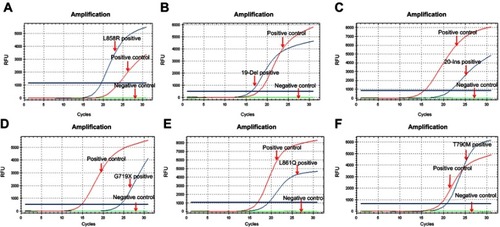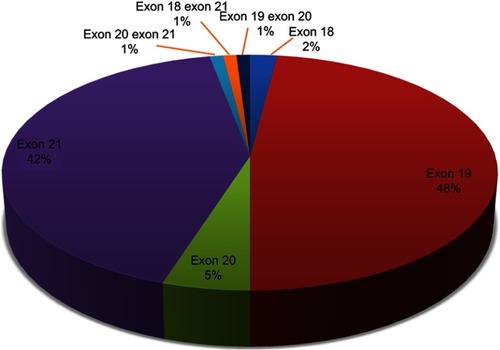Figures & data
Figure 1 Representative curves of different mutation subtypes of EGFR gene.
Notes: Representative curves of L858R of exon 21 (A), 19-Del of exon 19(B), 20-Ins of exon 20(C), G719X of exon 18(D), L861Q of exon 21(E), and T790M of exon 20(F). (EGFR gene mutation was detected by ARMS method. The red curves represent positive control which presents the amplification curve, the green curves represent negative control which has no amplification curve, and the blue curves represent the lung adenocarcinoma tissue samples).
Abbreviations: EGFR, epidermal growth factor receptor; ARMS, amplification refractory mutation system.

Figure 2 Proportion analysis of EGFR gene mutation subtypes in the lung adenocarcinoma patients.
Notes: Exon 18, exon 19, exon 20, and exon 21 accounted for 2%, 48%, 5%, and 42%, of mutant EGFR gene, respectively. Double mutation of exon 18 and 21, exon 19 and 20, and exon 20 and 21 accounted for 2%, respectively.
Abbreviation: EGFR, epidermal growth factor receptor.

Table 1 Association between the EGFR gene mutation and clinicopathological features of lung adenocarcinoma
Figure 3 Kaplan–Meier curves for 424 cases of lung adenocarcinoma patients with different clinicopathological features.
Notes: (A) Patients with exon 18 mutation had shorter OS than those with exon 19 and exon 21. (B–D) 424 cases of lung adenocarcinoma patients with wild-type EGFR gene, stage IV and poor differentiation had shorter survival. (E and F) 234 cases of mutant EGFR gene with EGFR-TKI treatment and surgery treatment had longer survival. (G and H) 190 cases of wild-type EGFR gene with surgery treatment had longer survival, but EGFR-TKI treatment was not significant (Kaplan–Meier analysis was used to plot the overall survival and statistical significance was assessed by log-rank test).
Abbreviations: OS, overall survival; EGFR, epidermal growth factor receptor; EGFR-TKI, EGFR-tyrosine kinase inhibitor.

Table 2 Analysis between average survival time (months) and clinicopathological features in 424 cases of lung adenocarcinoma
Table 3 Analysis of average survival time (months) in 234 cases of lung adenocarcinoma patients with EGFR mutation and 190 cases without EGFR mutation
Table S1 Clinicopathological features of 424 cases of lung adenocarcinoma
Table S2 Summary for logistic regression analysis of factors associated with EGFR gene status in lung adenocarcinoma
Table S3 Survival analysis of different EGFR gene mutation types
